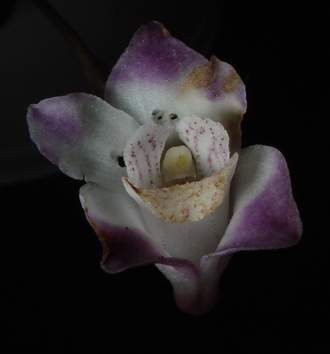Battle over the name
The new orchid species was discovered by a group of researchers in Colombia nearly two years ago, but due to the pandemic, the materials compilation has been delayed. – An article describing the species was ready as early as February, however; we did not really have an idea for its name – admits Prof. Marta Kolanowska. – After Russian invasion against Ukraine, the desire to show support for the Ukrainians came natural. As scientists, do not have the ability to fight, so we decided to dedicate this new orchid species to the struggling Ukraine.
The scientists decided to name the flower after Ukrainian President Volodymyr Zalensky and that's when the problems started.
For several months we tried to dedicate the orchid to the President of Ukraine, but unfortunately none of the three scientific journals in which we wanted to publish our article agreed to it. In my career, I have described more than 380 new species, naming them after my mother, the devil or even Aragog [a large spider in the Harry Potter series of novels – editor's note], and I have never encountered similar resistance. Scientists were disappointed. There are animals in the world named after former US President Barack Obama, and there is also reportedly a species of beetle named after Adolf Hitler, so it can be argued that the editor's reluctance in this regard is a little selective and discretionary.
– says Prof. Marta Kolanowska.
In the end, the scientists have decided on a name that is less controversial, but symbolically alludes to Polish-Ukrainian friendship. And so the falcon was born. The name refers to the folk song 'Hej sokoły', which is popular in both countries.
Where to look for the new species
Scientists disagree on the number of orchid species in the world. Some say there are 27,000, some 35,000. One thing is certain, every year new species are described, among other things, thanks to the work of the researcher from Lodz. – We try to describe them as quickly as we can – says Prof Kolanowska. – These flowers grow primarily in tropical forests, and these, as you realise, are being heavily damaged. So we try to get ahead of deforestation and describe as many species as we can. More species are disappearing at an alarming rate, not only because of the climate change, but above all because of human deforestation of tropical forests. – It is absurd that we are flying to the moon and sending probes to Mars, but we do not know what we have on earth – says Prof Kolanowska. – All the more so because many of these plants will never be known because they will die out before they can be described.
– We have found Teuscheria falcon in the Sibundoy Valley, where we plan to create a private nature reserve and, in cooperation with the University of Lodz, set up a research station there – says Prof. Marta Kolanowska. – All applications have already been submitted to the relevant authorities, and we have accumulated funds to buy the land, so there is hope that more people will be able to see this species in the wild. The Sibundoy Valley is a very orchid-rich region, whether there are other hitherto unknown plant species like this is unknown, as no one is conducting research there.
How to discover a new species?
Firstly, you need to know where to look for it. The Colombian jungle seems exceptionally abundant in this respect. Secondly, you need to know what to pay attention to. – Orchids are distinguished by the labellum – one petal that differs significantly from the others and serves to attract insects – the researcher explains. – Differences in the structure of labellums constitute the most common basis for describing new species.
I never know if I'm dealing with a new species. One thing I do know is that I don't know it, and then the adventure begins. You have to check all the available literature (sometimes dating back to the late 19th century) and make sure that no one has described it before. Then you have to check the herbaria, because maybe no one has described it, but someone has found it and preserved it. Only when we are sure that no one has done this before us can we get down to preparing an article for publication.
– says Prof. Kolanowska.
The work seems arduous, but the researchers are relentless in their efforts. The scientist from Lodz reveals that we can expect more discoveries soon. – I came back from my last trip to Colombia in September and we have several plants to describe – she admits. – The material is already partly compiled, but it still needs some time. We can probably expect publication early next year.
Source: Faculty of Biology and Environmental Protection, University of Lodz
Author: Justyna Kowalewska (3PR Consulting)
Photos: Ramiro Medina Trejo


